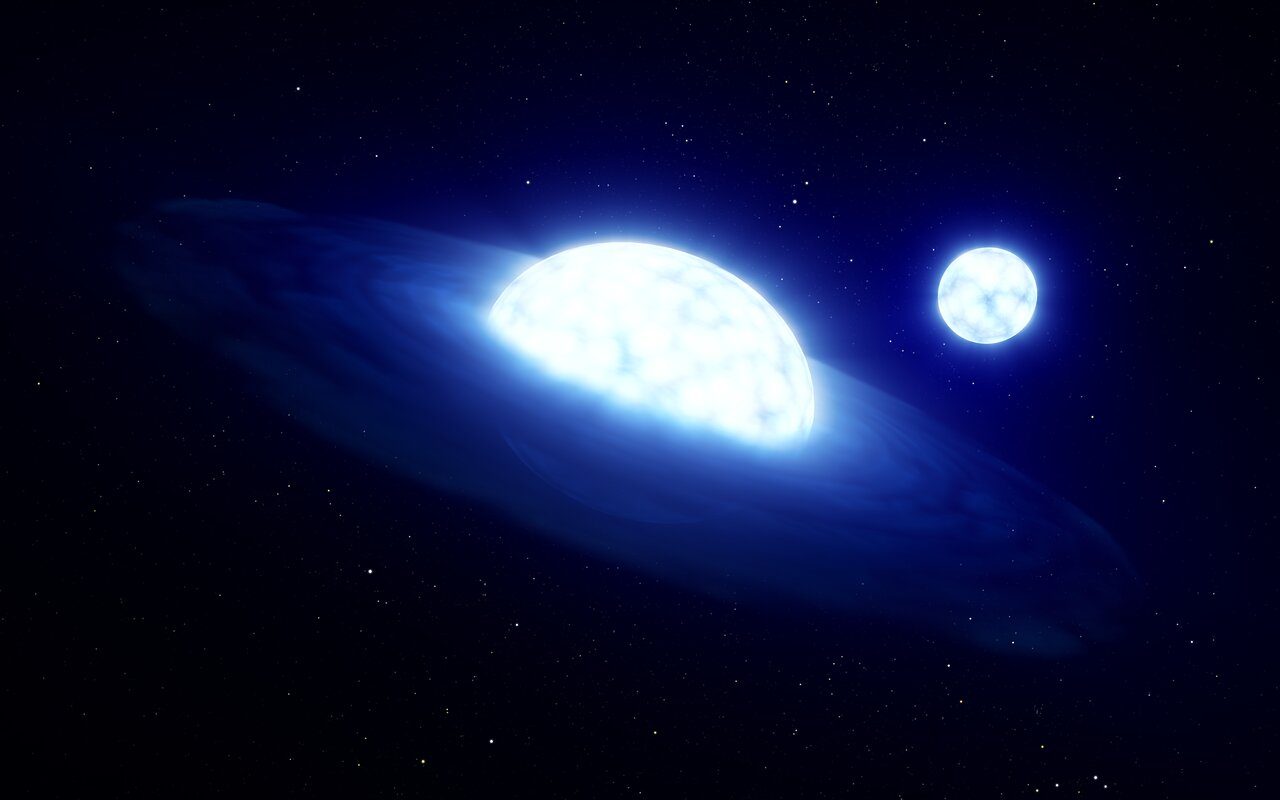It was considered the closest to Earth – but now the so-called black hole of the HR 6819 system has become a phantom: instead of a triple system with a “dark third”, it is a special double star system, the results of the new investigation show. Apparently, one of the partners there recently became a victim of the “stellar vampire”: one of the stars sucked a lump from the other, which gave the system its unusual features.
Their gravity is so strong that not even light can escape it: many people are interested in the mysterious black holes of the universe because of their amazing physical features. A study two years ago, in which scientists reported the effects of a black hole in our cosmic neighborhood, found a media echo. The research team led by Thomas Rivinius of the European Southern Observatory (ESO) focused on the HR 6819 system, which is about 1,000 light-years away from us. They concluded from the data obtained with the 2.2-meter MPG/ESO telescope that it is a special trio. According to their interpretation, it consists of a star orbiting an invisible body of about four solar masses every 40 days and a second star in a much wider orbit. The researchers concluded that the “dark third” must be a stellar black hole. This is how it became known as the closest black hole to date.
The “discoverers” cooperate with the skeptics
But soon after publication, other astronomers expressed doubts. According to them, the data in which Rivinius and his colleagues perceived the gravitational influence of a black hole can also be interpreted differently. Rivinius and colleagues are neither surprised nor offended by these reactions: “Not only is it normal, but the results should also be called into question,” says Rivinius, “and the result makes the headlines all the more so.” The team of astronomers from the University of Leuven in Belgium was also among the skeptics: Julia Budensteiner and her colleagues demonstrated another possible explanation for the same data: HR 6819 could therefore be a system with only two stars in a 40-day orbit. However, this alternative scenario without the presence of a black hole assumes that one star has recently lost a significant portion of its mass to the other star.
In the end, the two teams worked together to solve the mystery – allowing them to pool their resources and knowledge to uncover the true nature of this system. “However, we hit the limit on the existing data, so we had to use a different observational strategy to decide between the two possible scenarios,” says Abigail Frost of the University of Leuven, who led the joint research team’s study. The new findings are based on clearer observations of HR 6819 provided by ESO’s Very Large Telescope (VLT) and Very Large Telescope Interferometer (VLTI).
There is no such thing as a “dark third party”.
“The scenarios we were looking at were very straightforward, very different, and easy to distinguish with the right tool,” Rivinius says. “We agreed that there were two light sources in the system. So the question was whether they were orbiting close together, as in the naked star scenario, or far apart, as in the black hole scenario,” explains the astronomer. To differentiate the two proposals, the joint team used both the VLTI’s GRAVITY instrument and the Multi-Unit Spectral Explorer (MUSE) instrument on the VLT.
This is how the mystery was finally solved: “MUSE confirmed that there is no bright companion in another orbit, while GRAVITY’s high spatial resolution was able to resolve two bright sources only a third of the distance between the Earth and the Sun separated them,” According to Frost. “This data proves to be the final piece of the puzzle, allowing us to conclude that HR 6819 is a binary star system without a black hole.”
Evidence for a “stellar vampire”
The researchers stress that the system is by no means “boring”. “Our best interpretation of the data so far is that we detected this binary star system in the instant after one of the stars sucked the atmosphere out of its companion star. This is a common phenomenon in nearby binary systems, sometimes referred to as stellar vampire,” says Bodensteiner. “While the donating star was losing some of its material, the receiving star started to rotate faster.”
Frost continues: “It is very difficult to capture such a phase after the exchange because it is so short. This makes our results for HR 6819 very exciting. Because the system is an ideal candidate for studying how vampire influences the evolution of massive stars and thus the emergence of associated phenomena such as gravitational waves and explosions violent supernova,” says Frost. So the joint team now plans to continue monitoring HR 6819 closely: They want to use the new monitoring data to better understand its properties and gain clues to the evolutionary history of this binary system.
Researchers also remain optimistic about the search for stellar black holes – despite the current omission: stellar black holes will still be very difficult to find due to their nature, but there appears to be a lot of discovery potential. “It is estimated that there are tens to hundreds of millions of black holes in the Milky Way alone,” says co-author Dietrich Bade of ESO. So it seems only a matter of time before some feel themselves through their influence.
Source: ESO, technical article: Astronomy and Astrophysics, doi: 10.1051/0004-6361/202143004

“Alcohol buff. Troublemaker. Introvert. Student. Social media lover. Web ninja. Bacon fan. Reader.”







More Stories
This is how our brain chooses what information it will remember in the long term
Up to 100 pilot whales stranded in Western Australia – Science
Huge radiation explosion from a magnetar – forschung.de